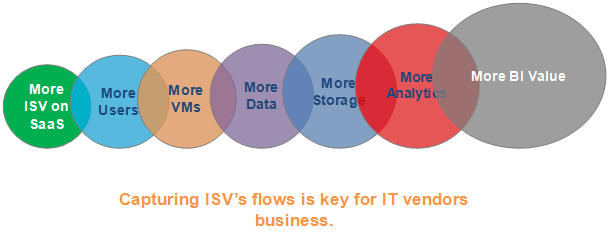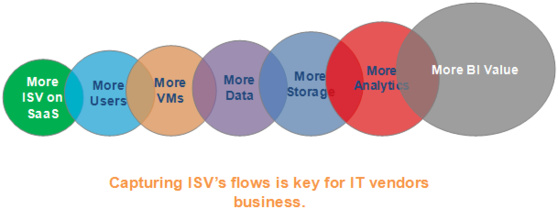The importance of digital transformation is such that the digital interfaces between a company and its clients play a major role in a company’s success.
What would Uber be without its mobile interface? Software has gone from being complementary to an offering to being the deciding factor in a purchase, and often the one that wins a market more quickly. The term “uberisation” is now commonly used, sacralizing the supremacy of the user experience over the product itself.
This user experience is based on innovation, which has become the quickest and, when it works, the cheapest way to establish a market position.
It’s a well-known formula: take a traditional business, split it up, invest heavily in a multi-terminal software solution and play on the mass market effect. If you’re quick enough you can crush the competition, if not you’ll get bought out.
What would Uber be without its mobile interface? Software has gone from being complementary to an offering to being the deciding factor in a purchase, and often the one that wins a market more quickly. The term “uberisation” is now commonly used, sacralizing the supremacy of the user experience over the product itself.
This user experience is based on innovation, which has become the quickest and, when it works, the cheapest way to establish a market position.
It’s a well-known formula: take a traditional business, split it up, invest heavily in a multi-terminal software solution and play on the mass market effect. If you’re quick enough you can crush the competition, if not you’ll get bought out.
The digital footprint: A new Eldorado

But this is just a first step beyond the purely economic activity. A new source of value is to be found in the digital traces we all leave behind us and their monetization. Let’s not get into the debate about who the digital trace belongs to; he who walks the path or he who builds it …Whatever, these traces and the use thereof are sources of income. This is the underlying philosophy behind big data - knowing how to collect and monetize the information.
The value that was originally based on a physical offering is displaced to the means of accessing that offering and then to the information generated by using that means.
The value that was originally based on a physical offering is displaced to the means of accessing that offering and then to the information generated by using that means.
An example:
Traditionally, the value of a hotel room lay in the physical space. However, with the rise of numerous booking platforms, the emphasis has shifted from the inherent value of the room to the platforms themselves. It's as if the hotel's communication system now holds more significance than the hotel.
A booking website isn't merely a convenient reservation tool. It's also a window into a person's preferences and behaviors. It can reveal whether a user is traveling alone or with a partner, their income range, if they have children, the countries they frequent, and more. While this information is valuable to the booking platform, it becomes even more potent when combined with data from other sources. This amalgamation creates a detailed profile of a user's preferences, intentions, and expectations. The ease of this data linkage has increased, especially with the rise of integrated sign-up options offered by platforms like Facebook, Google+, and LinkedIn. We willingly contribute and connect to these databases to an extent that's truly astounding.
From this standpoint, controlling the flow of information is vital. However, the decentralized nature of the internet makes this challenging. If controlling the entire channel isn't feasible, then controlling the entry point is the next best thing. This is why software developers have become pivotal for many industry giants. IBM, recognizing early on that software is paramount, has not only expanded its software portfolio but has also evolved into a hub for software developers, offering tools and cloud solutions.
Beyond IBM, the entire industry is vying for software developers, especially those who specialize in niche sectors. Securing a software developer is akin to capturing their target market. Focusing on specific business lines allows companies to tap into high-growth areas.
Reflecting on the hotel industry, who truly understands it? Is it the hotel associations, major hotel chains, or platforms like Booking.com, Hotel.com, and TripAdvisor? Furthermore, who has a better grasp of the hotel customers – these platforms or the hotels that supply the end product? We're in an era where manufacturers are increasingly becoming mere suppliers to information creators. Just as private labels in retail have steadily encroached on shelf space, it's conceivable that after consolidating information, major entities might climb the value chain. In many ways, this shift is already underway.
A booking website isn't merely a convenient reservation tool. It's also a window into a person's preferences and behaviors. It can reveal whether a user is traveling alone or with a partner, their income range, if they have children, the countries they frequent, and more. While this information is valuable to the booking platform, it becomes even more potent when combined with data from other sources. This amalgamation creates a detailed profile of a user's preferences, intentions, and expectations. The ease of this data linkage has increased, especially with the rise of integrated sign-up options offered by platforms like Facebook, Google+, and LinkedIn. We willingly contribute and connect to these databases to an extent that's truly astounding.
From this standpoint, controlling the flow of information is vital. However, the decentralized nature of the internet makes this challenging. If controlling the entire channel isn't feasible, then controlling the entry point is the next best thing. This is why software developers have become pivotal for many industry giants. IBM, recognizing early on that software is paramount, has not only expanded its software portfolio but has also evolved into a hub for software developers, offering tools and cloud solutions.
Beyond IBM, the entire industry is vying for software developers, especially those who specialize in niche sectors. Securing a software developer is akin to capturing their target market. Focusing on specific business lines allows companies to tap into high-growth areas.
Reflecting on the hotel industry, who truly understands it? Is it the hotel associations, major hotel chains, or platforms like Booking.com, Hotel.com, and TripAdvisor? Furthermore, who has a better grasp of the hotel customers – these platforms or the hotels that supply the end product? We're in an era where manufacturers are increasingly becoming mere suppliers to information creators. Just as private labels in retail have steadily encroached on shelf space, it's conceivable that after consolidating information, major entities might climb the value chain. In many ways, this shift is already underway.
Several large player have copied / adapted their Marketing Development Program for the ISVs
For an IT vendor, there are two distinct perspectives when viewing an ISV:
However, I recognize that this might be an oversimplified approach. ISVs demand a program tailored to their needs, distinct from what's offered to resellers. This perspective sheds light on what marketing experts in top vendor companies think of these players. A resulting challenge emerges within sales departments about where revenue recognition should be attributed: is it direct or indirect?
- The Traditional Approach: Here, the ISV is perceived as an end user who purchases my solutions through a reseller or a system integrator.
- The Cloud Perspective: In this view, the ISV is a company that, due to its clientele, will increasingly utilize my solutions. Since many of them aren't bound by geographical constraints, they can even assist in indirectly marketing my digital solutions to other regions. The more I support them, the more my solutions are sold. An added bonus is that they tend to be more loyal partners compared to resellers who might simply offer what's in demand.
However, I recognize that this might be an oversimplified approach. ISVs demand a program tailored to their needs, distinct from what's offered to resellers. This perspective sheds light on what marketing experts in top vendor companies think of these players. A resulting challenge emerges within sales departments about where revenue recognition should be attributed: is it direct or indirect?
If you are reading this article you are probably interested in the world of software. Here is a quick overview for you to browse, or, if you are a potential supplier, to develop your market.
The market is very fragmented which is explained by the need for local offerings, due to product interface, but also often because of specific regional rules and regulations. The majority of software publishers employ between 10 and 250 people which makes them relatively easy to prey on, especially since the move to the SaaS business model has taken its toll on cashflow for many of them.
See statistics from the compuBase database for ISVs
More statistics from the compuBase database for ISVs by country
The compuBase database has companies with a declared software publishing activity. This figure continues to increase with the development of web-centered solutions. Now lots of companies can claim they publish software. If competition is tough for business process software publishers (ERP, CRM etc…) and a certain concentration inevitable, business software publishers who boarded the SaaS train in time have a glorious future ahead of them.


 Consulting Services
Consulting Services
















